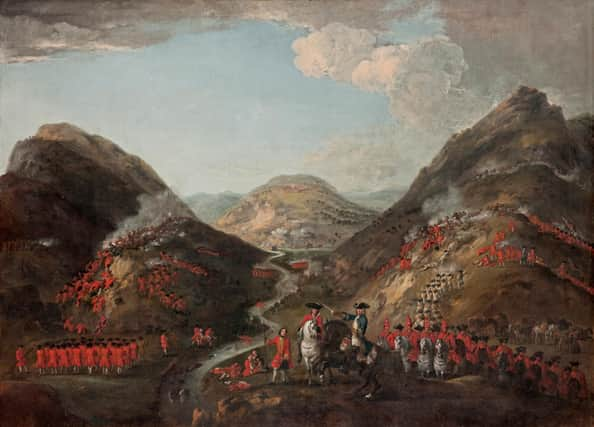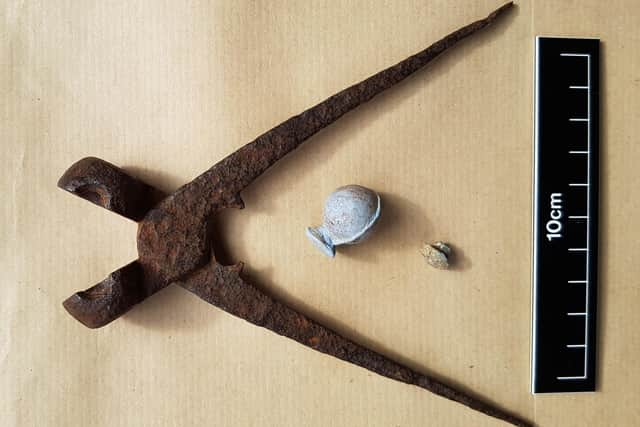Battle of Glenshiel: Tiny lead fragment sheds new light on 'nervous' British Army after Jacobite clash


The material was found at the site of the Battle of Glenshiel, when around 1,200 Jacobites along with 240 Spanish fighters took on a Government force of around 1,100 men close to the Shiel Bridge 301 years ago today.
The Jacobites, led by the Earl of Tullibardine, were defeated and forced to retreat from the slopes of Sgurr na Ciste Dubhe with their Spanish comrades surrendering less than 24 hours later.


Advertisement
Hide AdAdvertisement
Hide AdBut, according to research by the National Trust for Scotland, the discovery of the lead fragment at the site of the nearby Government camp suggests the troops were not at ease with their victory, with the material indicating the soldiers were hurriedly making more ammunition at their camp on the night of the battle to prepare for a resurgence of the rebels who had disappeared into the hills.
Derek Alexander, head of archaeology at NTS, said he now believes the piece of lead, found at the site by a metal detectorist in 2018, was an off-cut from the process of making musket balls.
He said: “To fire the ball, the makers would have had to have snipped of this extra bit of lead. This would have left a small-off cut that would probably have been returned to the pot so no lead was wasted.
“This led to a eureka moment, sitting at my flat during lockdown, when I realised a small fragment of lead we’d found at the site in 2018 was in fact a snipped-off sprue from a musket ball.
“This had been found by metal-detecting down by the river where the Government camp site would have been. It was easy to picture the troops after a heavy day of fighting frantically casting new musket balls to try and supplement their dwindling resources.”
Mr Alexander said the lockdown period had given him a chance to “stand back” and look at what had been earlier unearthed at Glenshiel by volunteers on the NTS Thistle Camps.
He added: “Wightman was nervous that he might be attacked or forced to fight on the following day, especially as most of his troops had used all but two of their 18 rounds.”
“It is amazing how such a small archaeological find can paint such a graphic picture in your mind and lead you to ponder just what the intentions were of people at the time.”
Advertisement
Hide AdAdvertisement
Hide AdThe site of the Battle of Glenshiel lies close to the A97 road to Kyle of Lochalsh and the Isle of Skye.
The catalyst for the 1719 Rising was the outbreak of war between Spain and Britain the year before with the Spanish resurrecting a Jacobite rising in order to increase pressure on the British government.
The Spanish forces set out to invade Britain in March 1719 but the fleet was wrecked by a storm and the invasion abandoned, but a small contingent of Jacobite and Spanish troops landed in Scotland.
The Battle of Glenshiel, fought on June 10 1719, started at around 5pm and was over within three hours. Wightman lost 25 men with a further 139 wounded No fatalities were recorded among the Jacobites but their defeat at Glenshiel marked the end of the 1719 effort.
A message from the Editor:Thank you for reading this story on our website. While I have your attention, I also have an important request to make of you.With the coronavirus lockdown having a major impact on many of our advertisers - and consequently the revenue we receive - we are more reliant than ever on you taking out a digital subscription.Subscribe to scotsman.com and enjoy unlimited access to Scottish news and information online and on our app. With a digital subscription, you can read more than 5 articles, see fewer ads, enjoy faster load times, and get access to exclusive newsletters and content. Visit https://www.scotsman.com/subscriptions now to sign up.
Our journalism costs money and we rely on advertising, print and digital revenues to help to support them. By supporting us, we are able to support you in providing trusted, fact-checked content for this website.
Joy Yates
Editorial Director
Comments
Want to join the conversation? Please or to comment on this article.